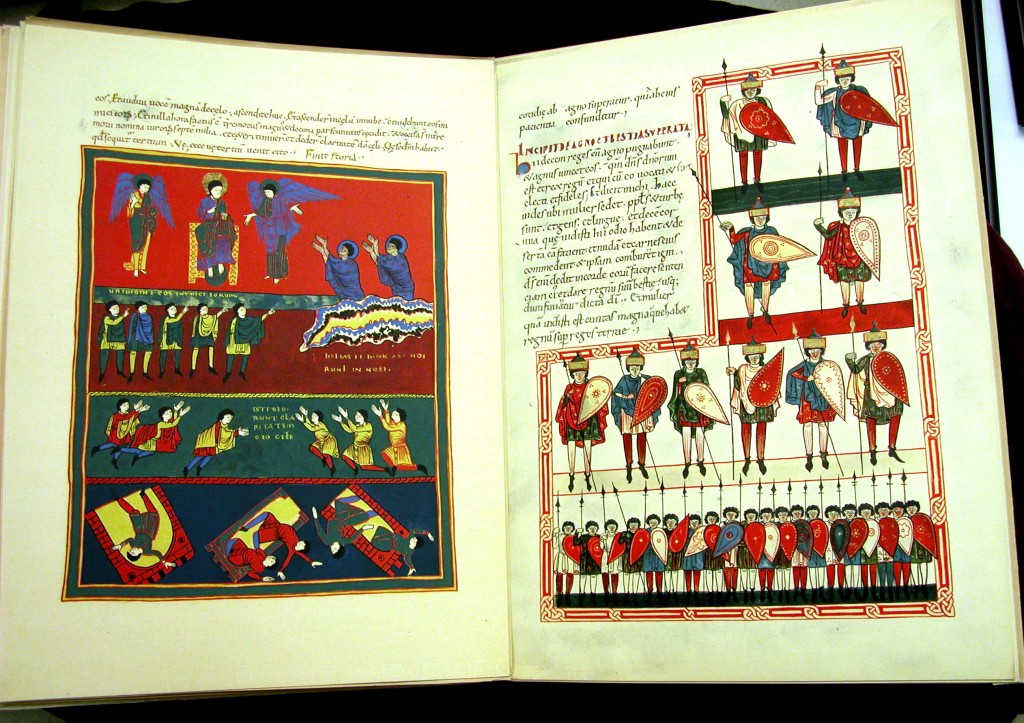A thousand years ago. One thousand years ago our forbears lived in the so called “Dark Age.” They themselves did not think it was dark, and they were only half wrong….
…That was all to the good, in the view of those of us who are not of Saracen stock. There were other alleviations in life in the tenth-century world. Few plagues and epidemics are reported. Neglected land was brought back into cultivation, new agricultural techniques improved the yield of thin, exhausted fields. Population increased, with an increase in food production, but usually at a faster rate. The population growth and the physical and spiritual betterment of the people may be traced to a new profusion of proteins, in the form of broad beans, peas, chick peas, and lentils. Some scholars perceived a mysterious demographic pulse in the world, for a similar population explosion was also evident in China, Islam, and the Scandinavian north.

—The Codex Egberti, commissioned by Egbert, Archbishop of Trier, opens with a dedication and a portrait of the Bishop on a double page in gold and purple. Two monks at Egbert’s feet, Kerald and Heribert of the Benedictine Abby on the Island of Reichenau, present the volume to the donor. This is followed by four impressive full-page illustrations of the Evangelists, and 51 narrative pictures comprising the earliest picture cycle of the Life of Christ in the history of manuscript illumination. Some of the images have been attributed to the Master of the Registrum Gregorii.—Read More:http://www.historyofinformation.com/expanded.php?id=2039
The Western world of 1000 was fragmented, atomized; it was a bundle of localisms. England, to be sure, enjoyed a brief cohesion under Edgar the Pacific ( 959-975 ). After pledging allegiance to Edgar at Chester eight lesser kings manned the oars of his boat to row him, as coxswain, down the River Dee. But Edgar died young, and troubles aplenty awaited his successors, including Ethelred the Unready, or the Stupid.
France was a collection of baronies and dukedoms, mutually hostile, united chiefly by opposition to their king. The nominal king of France was Lothair, next to last of the line of Charlemagne; he ruled precariously only over Paris and the Ile-de-France, and hardly dared venture beyond the limits of his royal domain.

—Issued in portfolio. This eleventh-century manuscript of the text of the Apocalypse includes the earliest version of the commentary by the eighth-century Spanish monk Beatus. Beatus of Liebana (d.798) wrote a commentary on the Apocalypse, the final book of the New Testament, and it became important throughout Europe. Many copies of Beatus’ commentary have survived, suggesting its popularity and influence in the medieval times. The influence of the Spanish Beatus manuscripts is clear in this example, a mid-eleventh century French Beatus The tradition of manuscript illumination which would evolved in Spain in the 10th and 11th centuries was often based on reproducing the commentary on the Book of Revelation. The Beatus text was regarded as a symbol of Christian resistance to the Muslim Arabs who dominated much of the Iberian Peninsula in the early Middle Ages. —Read More:http://speccoll.library.arizona.edu/exhibits/illuman/11_02.html
Italy was a power vacuum. The north was a congeries of nearly independent city-states, imperial fiefs, bishoprics wielding temporal rule. Rome and the surrounding Papal States were the property of the Church Calabria, Apulia, and the south belonged to the Eastern Empire, Sicily to Islam.
Only in Germany was there a national unity, under Otto I, properly termed the Great. Duke of the Saxons and King of the East Franks, he checked the invading Hungarians, Slavs and Danes, fostered the Christian faith, and made alliance with Byzantium. In 962 he revived the Roman Empire, with himself as emperor. In 973, his son Otto II became emperor. But his empire was a hollow thing; it had no imperial administration and little control over the mighty dukes,barons, and prelates of Germany. As yet it occurred to no one to call the new Roman Empire holy. ( to be continued)…





 COMMENTS
COMMENTS